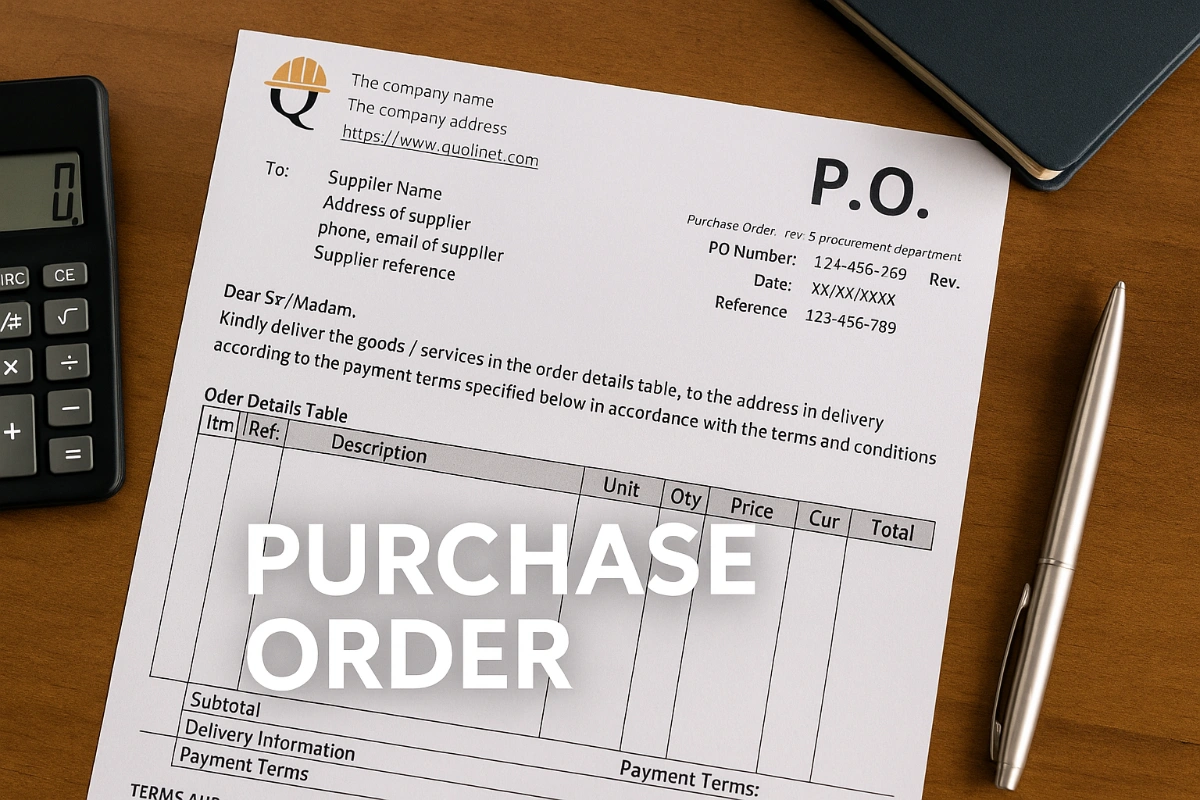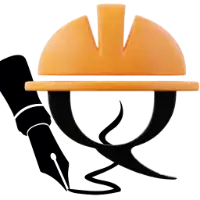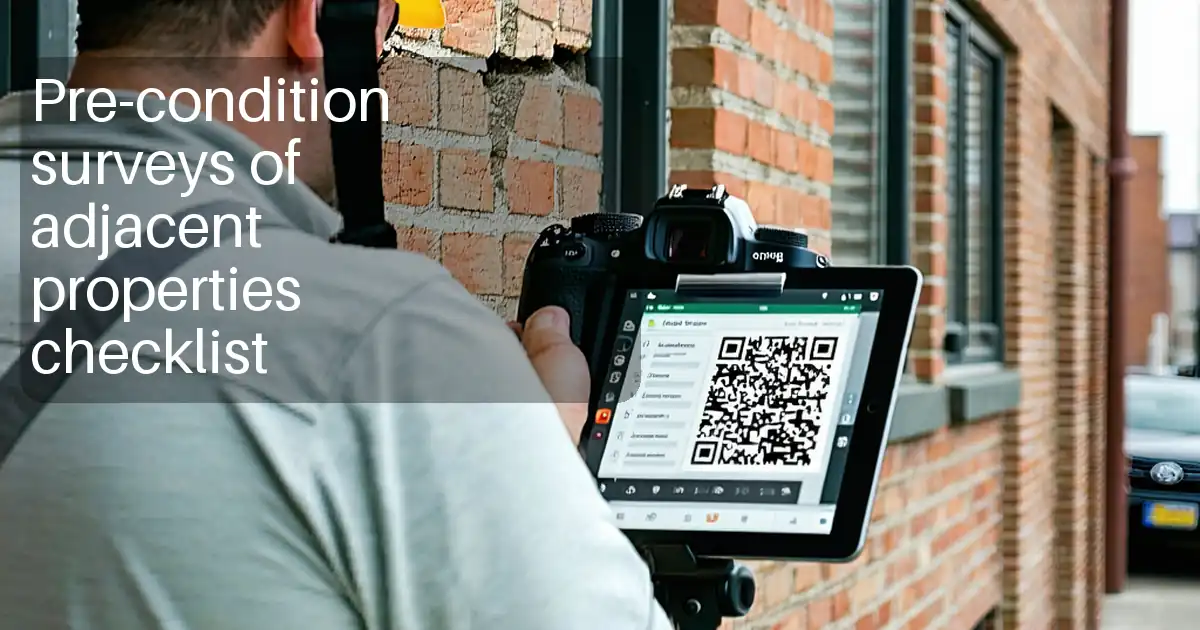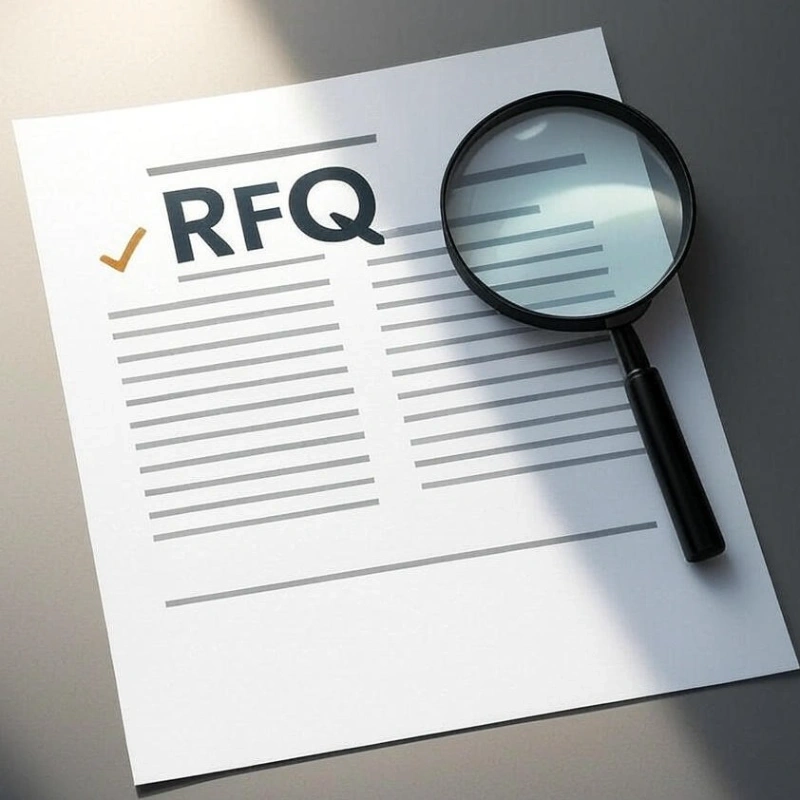Purchase Order (PO): Definition, Legality, Workflow, and Construction Use
What Is a Purchase Order (PO) and Why Is It Important?
A Purchase Order (PO) is a legal document issued by a buyer to a supplier to formally request goods or services under defined terms and conditions. Once accepted by the supplier, a PO becomes a legally binding contract that outlines what will be supplied, at what price, and under which delivery and payment terms.
In most organizations, a PO ensures transparency, accountability, and control over every transaction. It acts as proof of commitment and prevents disputes over pricing, quantities, or payment.
A Purchase Order also satisfies the basic elements of a contract — offer, acceptance, consideration, and mutual consent — making it enforceable in case of conflict.
How Does a Purchase Order Fit in the Procurement Workflow?
A PO is typically the final step of a structured procurement process that begins with a Material Requisition Sheet (MRS).
-
Material Requisition: A department submits a request for goods or services.
-
Sourcing: The request moves through one of three paths:
-
RFQs (Request for Quotations) for new or custom materials.
-
Local Stock if the materials already exist in inventory.
-
Pre-Approved Suppliers for recurring or standardized items.
-
-
Evaluation: RFQ responses are compared using price and compliance sheets to ensure the best value and conformity.
-
PO Issuance: A Purchase Order is then issued to the selected supplier — either from stock, a pre-approved vendor, or an RFQ winner.
-
Supplier Acceptance: The supplier reviews and confirms the PO, officially creating a binding agreement.
-
Delivery and Inspection: Goods or services are delivered, inspected, and matched with the PO and invoice before payment.
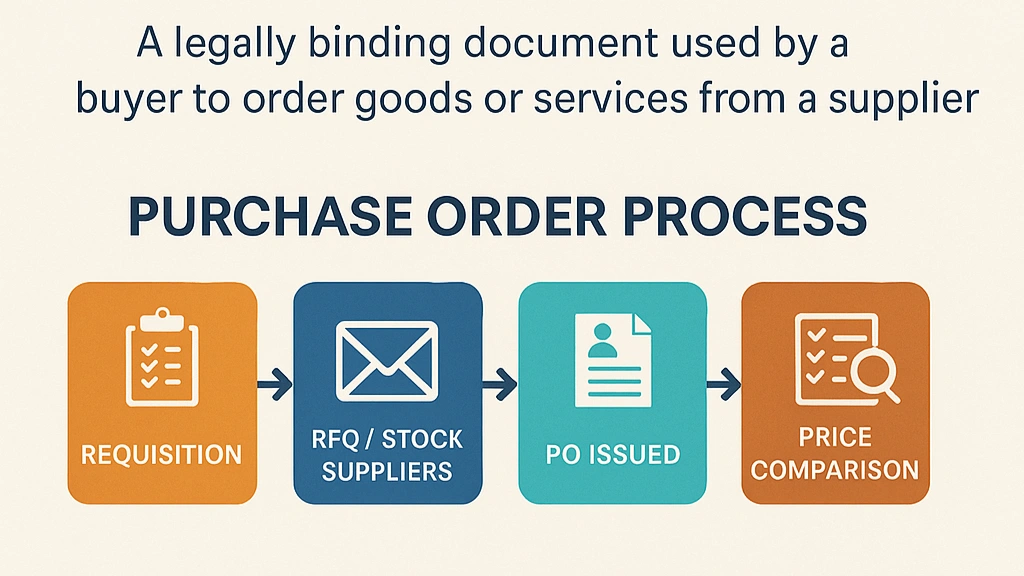
This workflow guarantees that every purchase follows a documented, traceable, and approved path — minimizing risk and unauthorized spending.
What Are the Key Components of a Purchase Order?
Every PO should include essential information to ensure clarity and legal validity:
-
PO Number – unique reference for tracking.
-
Buyer and Supplier Details – names, addresses, and contacts.
-
Issue Date – when the PO is generated.
-
Description of Goods or Services – detailed specifications.
-
Quantities and Units – exact order amount.
-
Unit Prices and Currency – confirmed cost basis.
-
Delivery Terms – address, method, and timeframe.
-
Payment Terms – e.g., Net 30, advance, or milestones.
-
Quality and Warranty Clauses – inspection and acceptance criteria.
-
Authorized Signature or Digital Approval – to validate the order.
What Should Be Considered Before Issuing or Accepting a PO?
Buyer’s Considerations Before Issuing a PO
-
Verify supplier qualification and registration.
-
Confirm budget availability and internal approval.
-
Ensure alignment with existing contracts or framework agreements.
-
Review delivery times, warranty, and payment terms.
-
Include all applicable taxes, duties, and governing law clauses.
Supplier’s Considerations Before Accepting a PO
-
Double-check scope and quantities against quotations.
-
Confirm pricing, delivery deadlines, and payment schedule.
-
Review any penalty or retention clauses.
-
Ensure jurisdiction and cancellation rights are acceptable.
-
Accept only after full understanding — because acceptance = legal commitment.
When Does a Purchase Order Become Legally Binding?
A Purchase Order becomes legally binding once the supplier accepts it — by signing, acknowledging in writing, or starting to deliver goods or services.
Before acceptance, it is considered an offer, not a contract.
Once accepted, both parties are obligated to perform according to the stated terms.
If either fails to do so, the PO can serve as evidence in legal or financial disputes.
What Are the Different Types of Purchase Orders?
-
Standard PO: For one-time, clearly defined purchases.
-
Blanket PO: Covers multiple deliveries over time under set conditions.
-
Planned PO: Used when quantities and prices are fixed, but delivery dates are flexible.
-
Contract PO: Issued under a master contract or long-term agreement.
In construction, POs often link material supply and subcontracted services directly to project cost codes and contract clauses, ensuring traceability and control.
What Is the Difference Between a Purchase Order and a Work Order?
| Aspect | Purchase Order (PO) | Work Order (WO) |
|---|---|---|
| Purpose | To purchase goods or materials | To authorize work or services |
| Issued To | Supplier or vendor | Contractor, technician, or internal team |
| Focus | Quantity, price, and delivery | Task description, scope, and schedule |
| Used In | Procurement & finance | Operations, maintenance, and projects |
| Result | Delivery of products | Completion of work |
| Example | Buying 500 bags of cement | Installing those 500 bags on site |
✅ In short: a Purchase Order buys things, while a Work Order authorizes work.
What Are Common Challenges and Best Practices for POs?
Common Challenges
-
Manual or duplicate entries causing errors.
-
Slow approvals and delayed supplier confirmations.
-
Lack of visibility on open or overdue POs.
-
Misalignment between PO, contract, and invoice data.
Best Practices
-
Use e-procurement systems to automate approvals and tracking.
-
Maintain standard PO templates with clear terms and conditions.
-
Attach price/compliance evaluation sheets for RFQs.
-
Audit open POs regularly.
-
Enforce a strict MRS → RFQ → PO sequence to ensure discipline and compliance.
📄 Download Free Purchase Order Templates (Excel, Word, PDF & WebP)
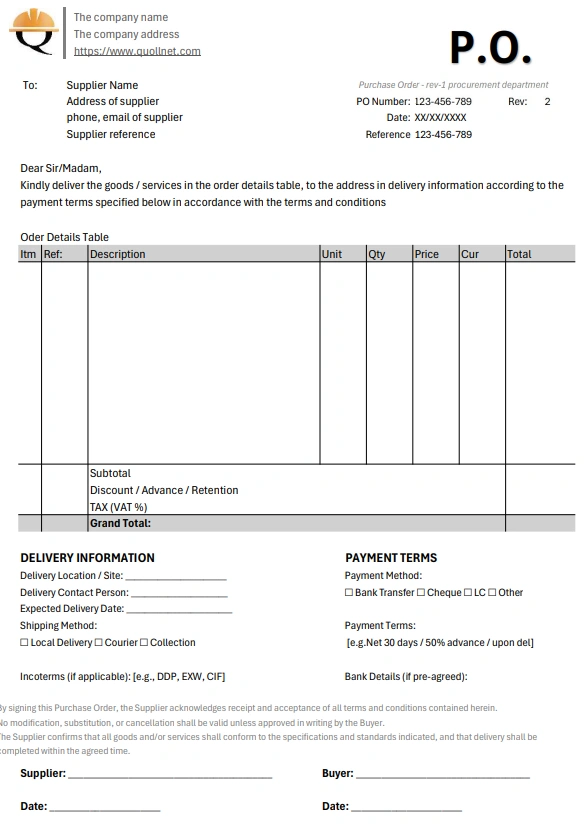
To help you implement a professional and legally compliant purchasing system, we’ve prepared ready-to-use Purchase Order templates in multiple formats:
-
📊 Excel Version: Automated totals and editable fields for item tracking.
-
🌐 WebP Image Version: Optimized layout preview for websites and internal portals.
👉 Download the Purchase Order Templates and adapt them to your company’s workflow or construction project.
Each template includes essential fields for PO number, supplier details, item descriptions, quantities, prices, delivery terms, and signature blocks.
Conclusion
A Purchase Order is both a contractual document and a control mechanism that ensures financial and procedural accountability.
When issued after proper evaluation and accepted with clear understanding, it protects both buyer and supplier.
In industries like construction, where cost control and documentation are vital, mastering the PO process ensures transparency, compliance, and fair project execution.
